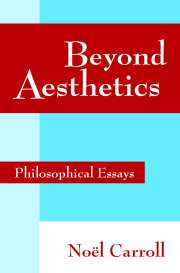Book contents
- Frontmatter
- Contents
- Foreword by Peter Kivy
- Introduction
- PART I BEYOND AESTHETICS
- Art and Interaction
- Beauty and the Genealogy of Art Theory
- Four Concepts of Aesthetic Experience
- PART II ART, HISTORY, AND NARRATIVE
- PART III INTERPRETATION AND INTENTION
- PART IV ART, EMOTION, AND MORTALITY
- PART V ALTERNATIVE TOPICS
- Notes
- Index
Beauty and the Genealogy of Art Theory
Published online by Cambridge University Press: 19 January 2010
- Frontmatter
- Contents
- Foreword by Peter Kivy
- Introduction
- PART I BEYOND AESTHETICS
- Art and Interaction
- Beauty and the Genealogy of Art Theory
- Four Concepts of Aesthetic Experience
- PART II ART, HISTORY, AND NARRATIVE
- PART III INTERPRETATION AND INTENTION
- PART IV ART, EMOTION, AND MORTALITY
- PART V ALTERNATIVE TOPICS
- Notes
- Index
Summary
Within the analytic tradition, those of us who take art as our field of study call ourselves either philosophers of art or aestheticians. From one perspective, these alternative labels could be seen as a harmless sort of shorthand. For two major concerns of the field, however it is named, are the theory of art, which traditionally pertains to questions about the nature of the art object, and aesthetic theory, which pertains primarily to certain dimensions of the experience of art (and also to the experience of certain features of nature). Thus, rather than identifying ourselves longishly as philosophers of art and philosophers of aesthetics, for economy's sake, we may simply refer to ourselves as one or the other, leaving the remaining label unstated, but understood. And where this is the motive behind the alternations of title, the ambiguous labeling seems quite harmless.
However, the ambiguity can also be understood to rest on a substantive and controversial claim – namely, that the theory of art and the theory of aesthetics are conceptually linked in such a way that the former can be reduced to the latter; that, in other words, there are not two, generally independent areas of philosophical inquiry here, but one unified field. Thus, we are called either philosophers of art or philosophers of aesthetics because, in most contexts of any significance, those titles signal a concern with the selfsame issues.
The view that the philosophy of art and the philosophy of aesthetics are conceptually linked is explicitly stated in what have been called aesthetic theories of art.
- Type
- Chapter
- Information
- Beyond AestheticsPhilosophical Essays, pp. 20 - 41Publisher: Cambridge University PressPrint publication year: 2001
- 2
- Cited by



